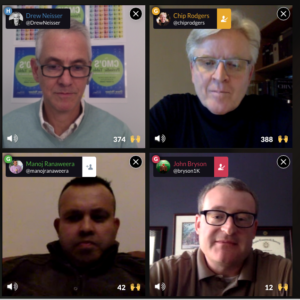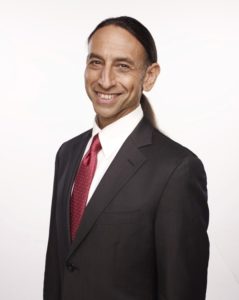 Maybe its because my late mother had a talk show in the early 70’s on a local cable channel in Newport Beach, California. Her show, Broadly Speaking, a punny name coined by my father (so you know that apple didn’t fall far from the tree,) attracted a remarkable collection of celebrated figures including Henry Kissinger and Herb Klein, both in town because of Nixon’s Western White House. Well anyway, I share this background as an explanation for why I really enjoy a new video podcasting platform called Blab. The audience may be small, as was the case with my mom’s show, but that doesn’t mean the guests and the conversations need be limited. In fact, I suspect this platform is going to be huge and I offer the following FAQ (frequently asked questions) in order to prep you for this eventuality.
Maybe its because my late mother had a talk show in the early 70’s on a local cable channel in Newport Beach, California. Her show, Broadly Speaking, a punny name coined by my father (so you know that apple didn’t fall far from the tree,) attracted a remarkable collection of celebrated figures including Henry Kissinger and Herb Klein, both in town because of Nixon’s Western White House. Well anyway, I share this background as an explanation for why I really enjoy a new video podcasting platform called Blab. The audience may be small, as was the case with my mom’s show, but that doesn’t mean the guests and the conversations need be limited. In fact, I suspect this platform is going to be huge and I offer the following FAQ (frequently asked questions) in order to prep you for this eventuality.
What is a Blab and how do you set one up?
Think Hollywood Squares meets Facetime. Essentially anyone with a web camera, internet access and a Twitter account can set up a Blab. You can also Blab from your iPhone or Droid with the app. That part is super easy. Just visit Blab.im and register. Then hit the purple “Start a new blab” button in the upper right hand corner of your screen and follow the instructions. You will need to come up with an 80-character or less name for your Blab, pick 3 topic tags and then schedule it. If you want to start right away you can or you can schedule it several weeks in advance. Important tech note—Blabs work best on Chrome.
Who is on Blab now?
From my experience thus far, it’s a rather eclectic crew ranging from social media influencers to random folks who simply stumble upon the conversation. In my recent Blab with Chip Rodgers, VP of Customer Experience at Ciena we had guests from as far a field as Manchester, England and Bangalore, India. Not surprisingly, a number of social media influencers like Brian Fanzo, Bryan Kramer, Joel Comm, Ted Rubin and Tamara McCleary are early adopters of Blab and have a habit of popping in and out of each other’s sessions.
Do I have to be on camera to participate?
One of the cool things about Blabs is that watchers can ask questions via a chat stream right next to the video stream. These live questions help enhance the overall conversation and allow the camera shy to still participate. Blab has its own social universe – by that I mean you have a Blab identity that you can use to follow other Blabbers and vice versa. Another way viewers participate is by virtually clapping — there are a couple of yellow hands on the lower right corner of each person on camera — and viewers show their appreciation by clicking on these hands.
How do you manage the Blabbers if you’re the host?
Just to be clear, up to four people can be on the video portion of Blab at once and the host/moderator is in complete control of the other three. When someone wants to be on-camera, they just click one of the empty Join boxes and the host can accept them or not. At any point in the conversation the host can kick someone off camera by clicking on the X.
Are there some technical hacks to improve sound and video quality?
Joel Comm, a Blab/podcasting vet, recommends using a Yeti microphone for sound quality but I had a bit of a problem with that my first time around. It turns out, I had to reset a sound setting on Skype to prevent the microphone from jumping to full volume and thus causing all sorts of mayhem. To simplify things, I just used a Bluetooth one-eared headset and this seemed to work pretty well. On the lighting front, definitely think about having extra light sources to brighten up your face. I actually have started using some pro lights that we already had in the office for in-house photography. And giving credit where credits due, I’m taking a cue from another master Bryan Kramer who I happened to notice uses pro lighting as well.
How do people find out about Blabs?
Once you sign up for a Blab, you will be notified about other Blabs as they are going live. Others will probably hear about it through social media. Blab is really well integrated into Twitter so during a Blab, viewers can share what they are watching on Twitter with ready made tweets that include the Twitter handles of those on camera. I suspect the audience will grow as word spreads and the quality of the content improves. [Some sessions are meatier than others!] Also, as you collect followers within Blab, I believe these folks are directly notified about your sessions.
What if I can’t watch it live–are their recorded versions?
Every host has the option of recording their Blab session. That it is also really easy although I missed this fact on my first Blab with Bob Kraut, the former CMO of Papa John’s. Fortunately about 10 minutes into it, a friend posted on the chat stream that I should be recording it! Doing so was just a matter of clicking the Record button on the left hand side of the screen. Another thing I really like about this platform is that they make it very easy to upload your Blabs to YouTube and then from there its easy to embed these videos anywhere. Here, for example, is my Blab with Chip Rodgers from yesterday.
When’s your next “Elements of Marketing” Blab?
You’re the best. Thanks for asking. I have Blabs scheduled every Monday and Friday at 2pm EST for the next couple of months with many of the folks featured in my book. Here are links to a few of these upcoming Blabs and by the way, you can register in advance for these and you will get a reminder right before it starts:
10/16: on Tiny Budgets with Julie Garlikov of Nuvesse
10/20: on Social Media Success with Scot Safon, former CMO of The Weather Channel
10/23: on Networking with Matt Sweetwood, former President of Unique Photo
11/05: on Organizing with Stephanie Anderson, CMO of Time Warner Cable Business Class
Who is behind Blab?
The two founders Shaan Puri and Furqan Rydhan are veteran developers having worked on Bebo before selling it to AOL for $800 million. Shaan is actively involved and was kind enough to jump into my conversation with Bob Kraut. These guys also have some big money VC backers and I suspect will come out of Beta with a splash any day now.
